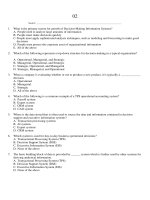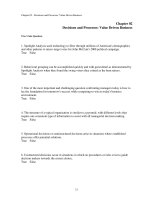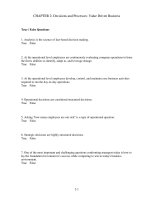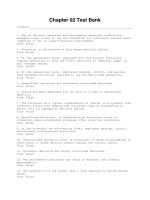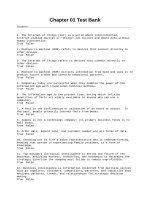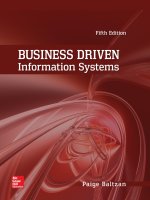Lecture Business driven information systems (4/e): Chapter 3 - Paige Baltzan
Bạn đang xem bản rút gọn của tài liệu. Xem và tải ngay bản đầy đủ của tài liệu tại đây (2.34 MB, 56 trang )
CHAPTER THREE
EBUSINESS
ELECTRONIC
BUSINESS VALUE
© 2014 by McGraw-Hill Education. This is proprietary material solely for authorized instructor
use. Not authorized for sale or distribution in any manner. This document may not be copied,
scanned, duplicated, forwarded, distributed, or posted on a website, in whole or part.
2
CHAPTER OVERVIEW
SECTION 3.1 – WEB 1.0 - EBUSINESS
•
•
•
•
•
Disruptive Technologies and Web 1.0
Advantages of Ebusiness
Ebusiness Models
Ebusiness Tools for Connecting and Communicating
The Challenges of Ebusiness
SECTION 3.2 – WEB 2.0 – BUSINESS 2.0
•
•
•
•
•
Web 2.0: Advantages of Business 2.0
Networking Communities with Business 2.0
Business 2.0 Tools for Collaborating
The Challenges of Business 2.0
Web 3.0: Defining the Next Generation of Online Business
Opportunities
SECTION 3.1
WEB 1.0
EBUSINESS
© 2014 by McGraw-Hill Education. This is proprietary material solely for authorized instructor
use. Not authorized for sale or distribution in any manner. This document may not be copied,
scanned, duplicated, forwarded, distributed, or posted on a website, in whole or part.
4
LEARNING OUTCOMES
1. Compare disruptive and sustaining
technologies and explain how the Internet and
WWW caused business disruption
2. Describe Web 1.0 along with ebusiness and
its associated advantages
3. Compare the four categories of ebusiness
models
4. Describe the six ebusiness tools for
connecting and communicating
5. Identify the four challenges associated with
ebusiness
5
DISRUPTIVE TECHNOLOGIES AND
WEB 1.0
Digital Darwinism – Implies that organizations
which cannot adapt to the new demands placed
on them for surviving in the information age are
doomed to extinction
How can a company like Polaroid go bankrupt?
6
Disruptive versus Sustaining Technology
What do steamboats, transistor radios,
and Intel’s 8088 processor all have in
common?
• Disruptive technology – A new way of
doing things that initially does not meet the
needs of existing customers
• Sustaining technology – Produces an
improved product customers are eager to
buy
7
Disruptive versus Sustaining Technology
8
Disruptive versus Sustaining Technology
Innovator’s Dilemma
discusses how established
companies can take
advantage of disruptive
technologies without
hindering existing
relationships with
customers, partners, and
stakeholders
9
Disruptive versus Sustaining Technology
10
The Internet and World Wide Web –
The Ultimate Business Disruptors
One of the biggest forces changing business is the
Internet – A massive network that connects
computers all over the world and allows them to
communicate with one another
Organizations must be able to transform as
markets, economic environments, and
technologies change
Focusing on the unexpected allows an
organization to capitalize on the opportunity for
new business growth from a disruptive technology
11
The Internet and World Wide Web –
The Ultimate Business Disruptors
The Internet began as an emergency military
communications system operated by the
Department of Defense
Gradually the Internet moved from a military
pipeline to a communication tool for scientists
to businesses
12
The Internet and World Wide Web –
The Ultimate Business Disruptors
World Wide Web (WWW) – Provides access to
Internet information through documents
including text, graphics, audio, and video files
that use a special formatting language called
HTML – hypertext markup language
Web browser – Allows users to access the
WWW
Hypertext Transport Protocol – The Internet
protocol Web browsers use to request and
display Web pages using URL – universal
resource locator
13
The Internet and World Wide Web –
The Ultimate Business Disruptors
Reasons for growth of the
WWW
•
•
•
•
Microcomputer revolution
Advancements in networking
Easy browser software
Speed, convenience, and low cost
of email
• Web pages easy to create and
flexible
14
Web 1.0 – The Catalyst For
Ebusiness
The Internet has had an impact on almost
every industry including
• Travel
• Entertainment
• Electronics
• Financial services
• Retail
• Automobiles
• Education and training
15
Web 1.0 – The Catalyst For
Ebusiness
Web 1.0 – A term to refer to the WWW
during its first few years of operation
between 1991 and 2003
Ecommerce – Buying and selling of
goods and services over the Internet
Ebusiness – Includes ecommerce
along with all activities related to internal
and external business operations
16
ADVANTAGES OF EBUSINESS
17
Expanding Global Reach
The Internet’s impact on information
•
•
•
•
Easy to compile
Increased richness
Increased reach
Improved content
18
Opening New Markets
Mass customization – The ability of an
organization to tailor its products or services
to the customers’ specifications
Personalization – Occurs when a
company knows enough about a customer’s
likes and dislikes that it can fashion offers
more likely to appeal to that person
19
Opening New Markets
The Long Tail – Refers to the tail of a typically
sales curve
20
Opening New Markets
Intermeidary – Agents, software, or
businesses that provide a trading
infrastructure to bring buyers and sellers
together
• Disintermediation
• Reintermediation
• Cybermediation
21
Opening New Markets
Business Value of Disintermediation
22
Improving Effectiveness
Clickstream data tracks the exact pattern of a
consumer’s navigation through a website
Clickstream data can reveal
• Number of pageviews
• Pattern of websites visited
• Length of stay on a website
• Date and time visited
• Number of customers with shopping carts
• Number of abandoned shopping carts
23
Marketing/Sales
Generating revenue on the Internet
• Online ad (banner ad) - Box running across a web
page that contains advertisements
• Pop-up ad - A small web page containing an
advertisement
• Associate program (affiliate program) - Businesses
generate commissions or royalties
• Viral marketing - A technique that induces websites
or users to pass on a marketing message
24
Improving Effectiveness
Website metrics include
• Visitor metrics
• Exposure metrics
• Visit metrics
• Hit metrics
25
EBUSINESS MODELS
Ebusiness model – A plan that details
how a company creates, delivers, and
generates revenues on the internet

